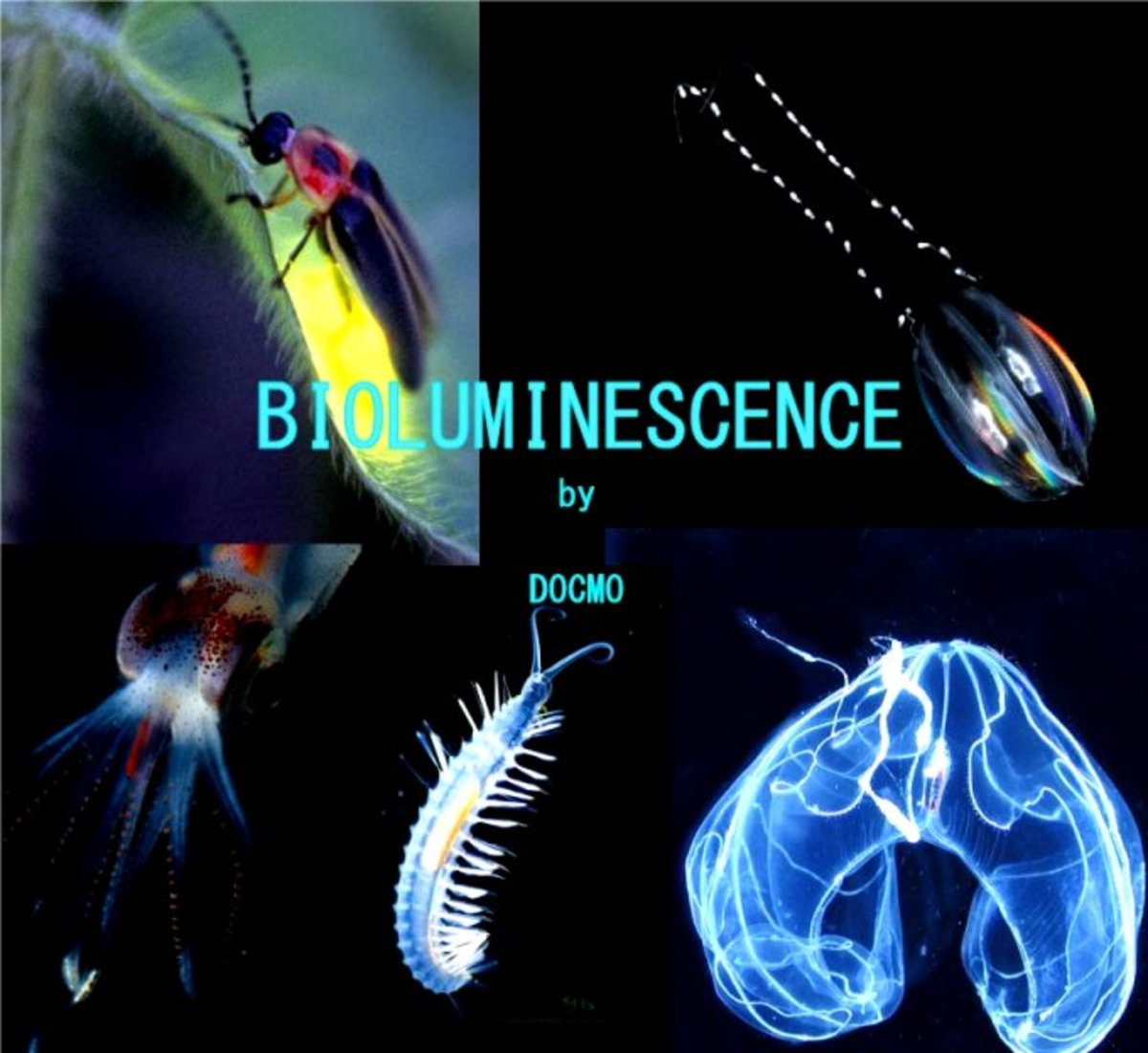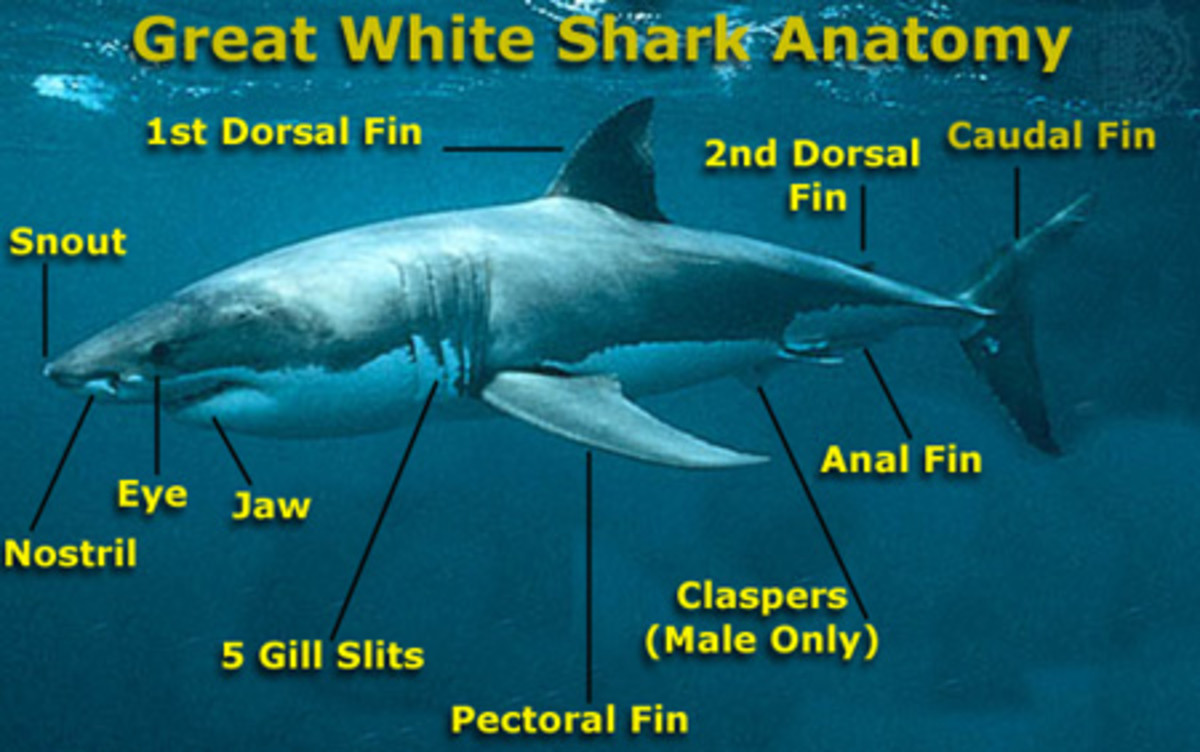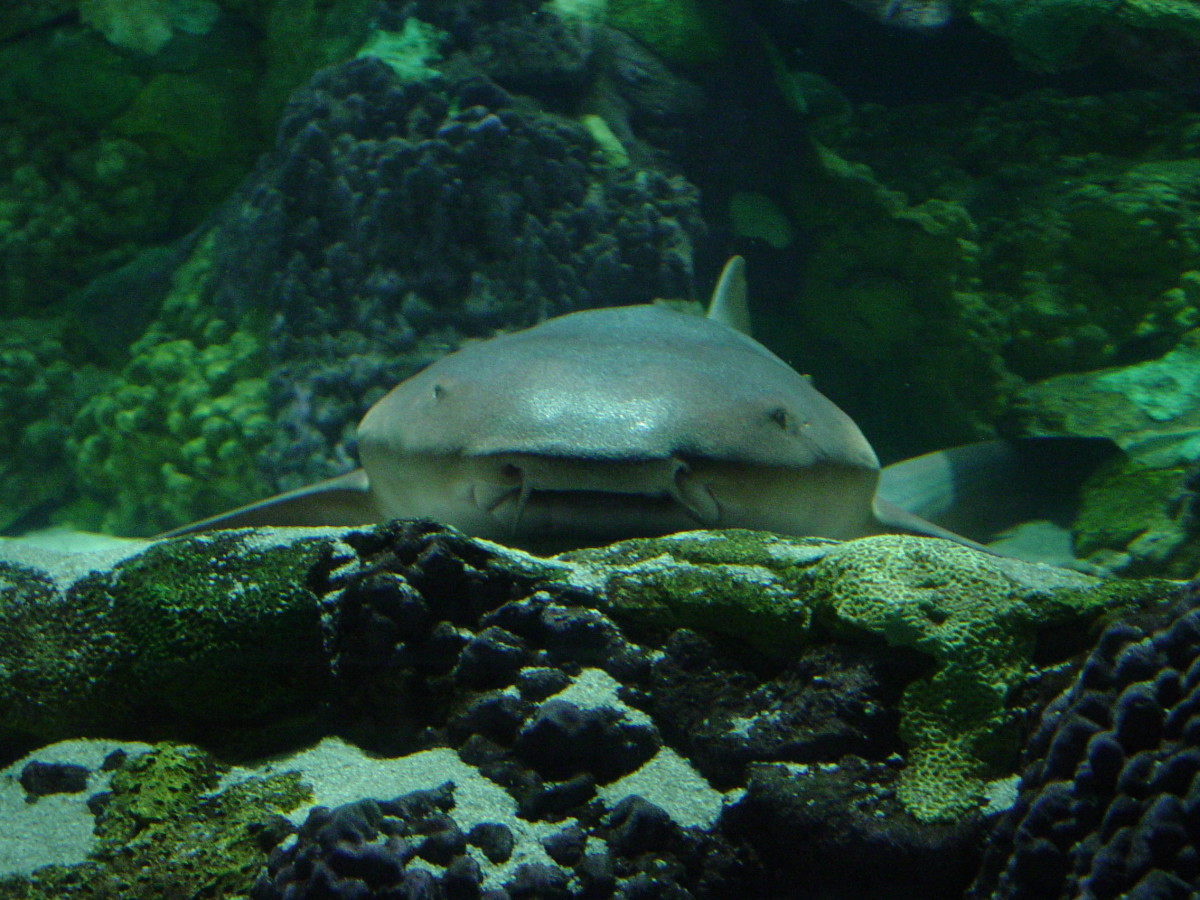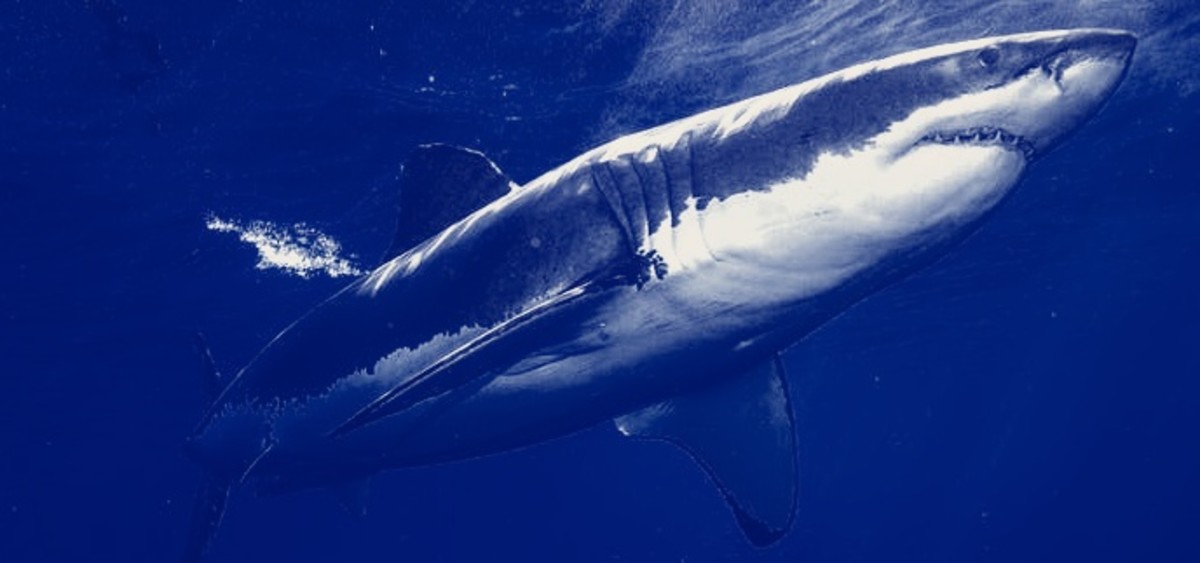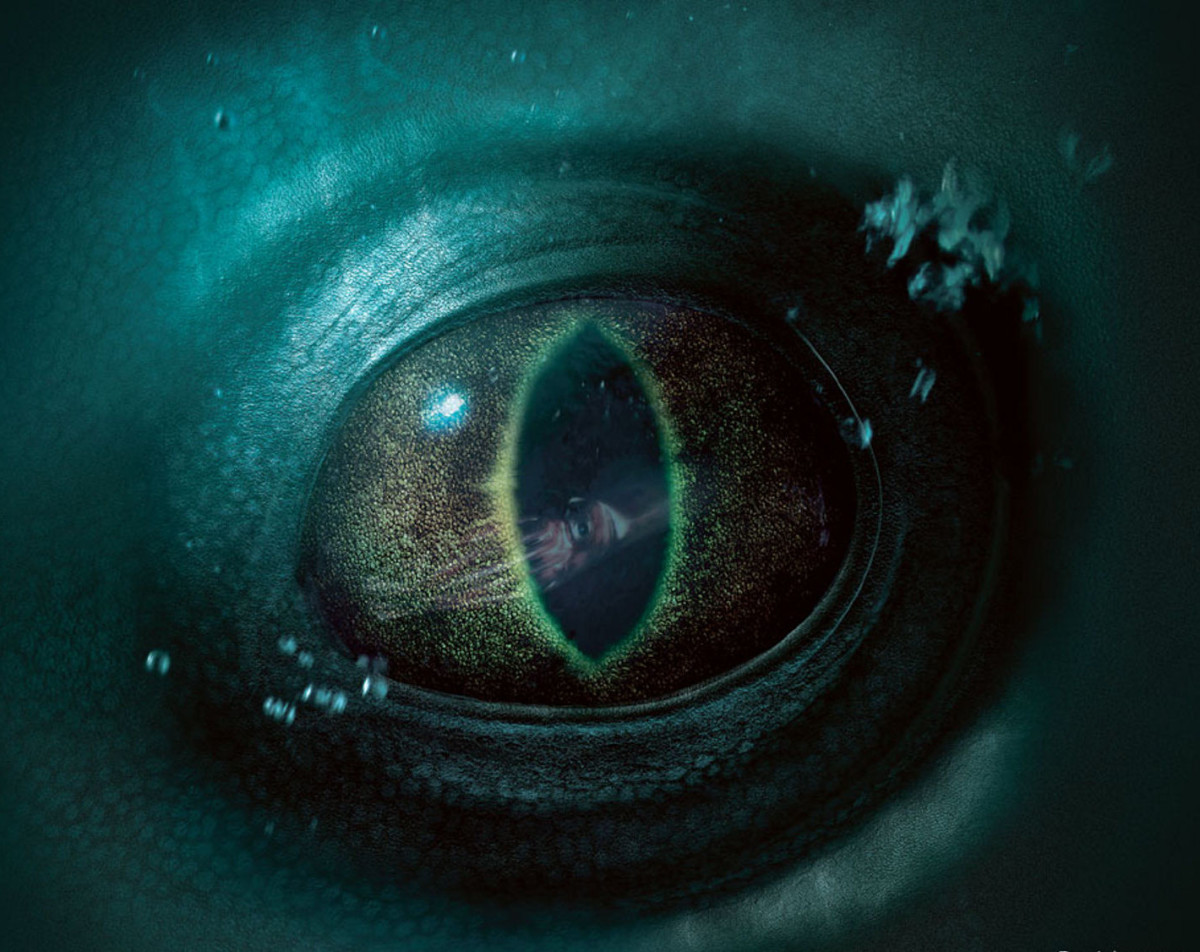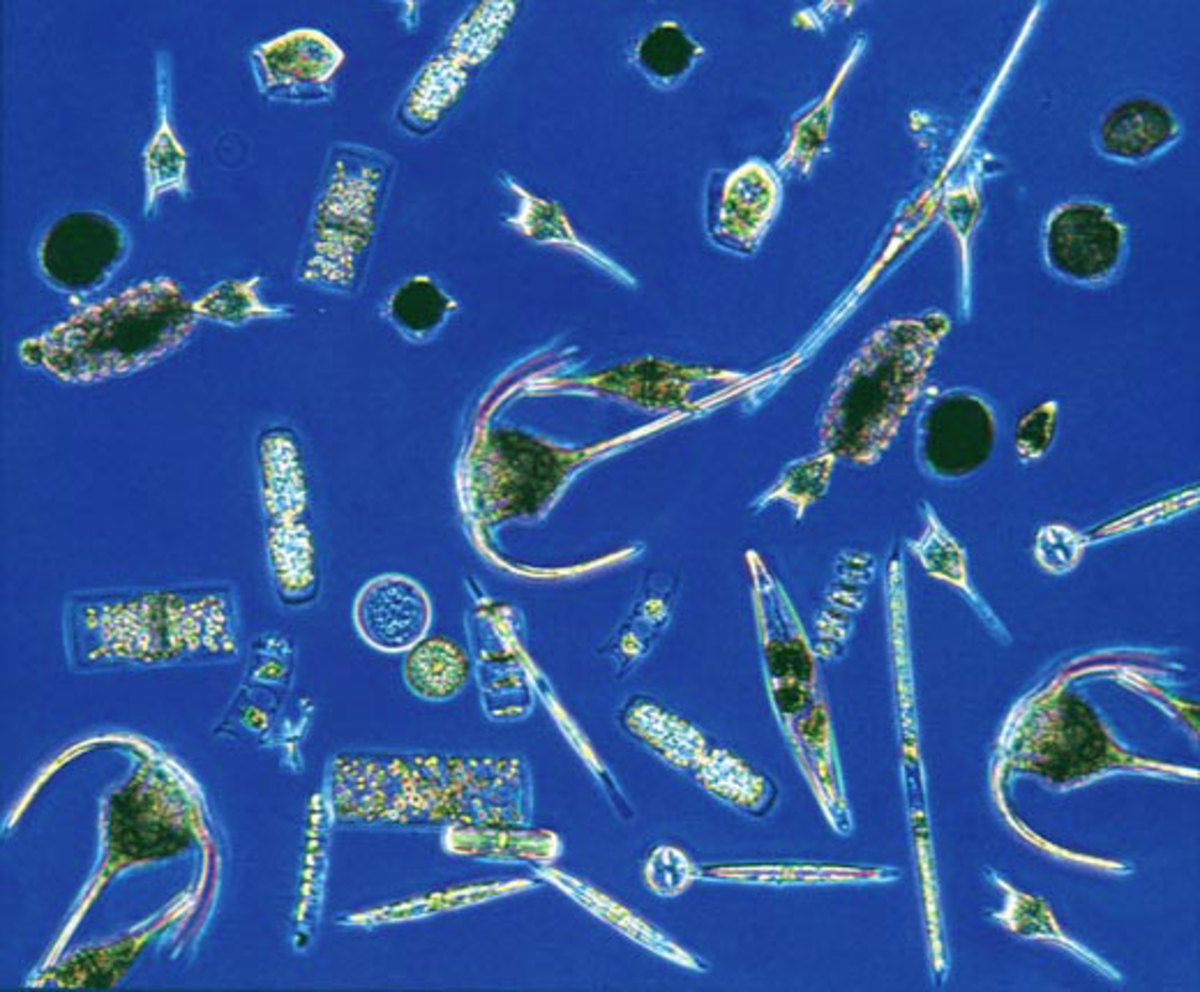Shella's Marine Life
Welcome!
Welcome to my Hub! I am an ever constant student of all things under the waves and I love to share the information I find fascinating with those who may not normally be exposed to it! My goal is to spread awareness of both the fascinating life forms and processes taking place and of our own impact on this complex environment, to educate people of all ages about marine animals and environments and the need for their conservation.
A little about me:
From a very young age I have been fascinated by the ocean. While other 5 year olds were watching Barney or Rugrats, I was watching National Geographic and Animal Planet and boring my parents to death with the facts I'd learned. I would go the library and instead of renting out children's books, I was in the science section looking at pictures of alien looking creatures. Taking in their bright colors and strange shapes.
As I got older the infatuation only intensified. I began compiling notes, binders full of information I had learned and cataloged. Sharks began to grab my specific interest and I engrossed myself in information about them, current research, scientific journals and other publications. While Sharks were of particular interest to me, the ocean as a whole still gripped me.
I am now in my 20's and my interest and desire for learning is stronger than ever. I look forward to sharing what I have learned and in the process learning as I do further research to provide you with the most up to date research and facts!
Please feel free to comment and ask questions! I will occasionally post brief quizzes and polls just for fun and please click the thumbs up if this was interesting and/or helpful to you! :
It is my belief that fear is the lack of knowledge and understanding. As humans, we have a need to understand the world around us, and accept that in many environments, we are no longer at the top of the food chain, and no longer in our element, therefore we must respect the life forms that dominate there. We must understand that an animal’s behavior is what it is because it’s what is essential to its survival and we must respect that. Once we do, we can work around those behaviors in order to peacefully interact with them.
A long long time ago our ancestors relied on their instincts to survive. These instincts had been selected for and therefore passed down through genetics because they allowed individuals to survive long enough to procreate. These instincts are still with us today, although we live in a very different world and they are not always practical or useful. Our ancestors feared the dark because there were predators adapted to hunt in the dark. Our ancestors feared deep water because they were not built to swim and to attempt to do so could result in drowning. We are genetically programmed to have fears for our own protection, but one must work past those fears to see all of the fascinating things just waiting to be discovered.
By learning why certain organisms behave the way they do, one can learn to view those behaviors objectively rather than personally and begin to replace fear with understanding.
Imagery from "Marine Predators and Their Jobs"
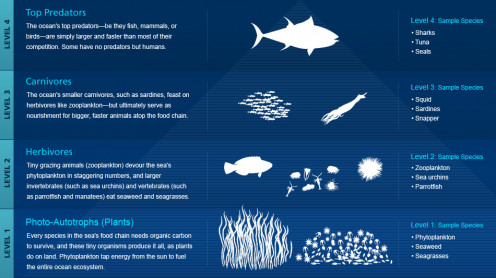
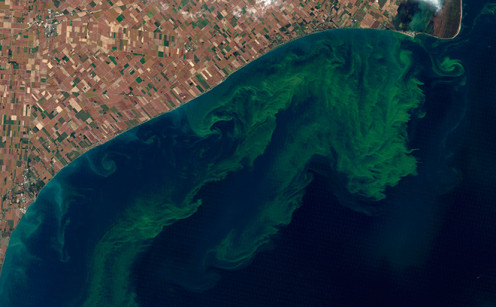
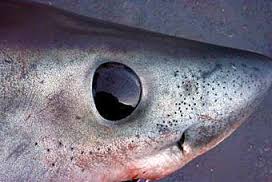
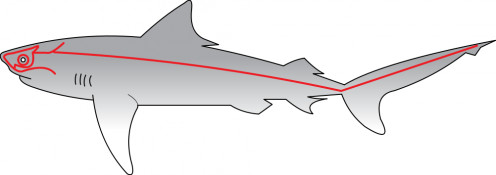
Tuna Eating Bait Ball
Krill
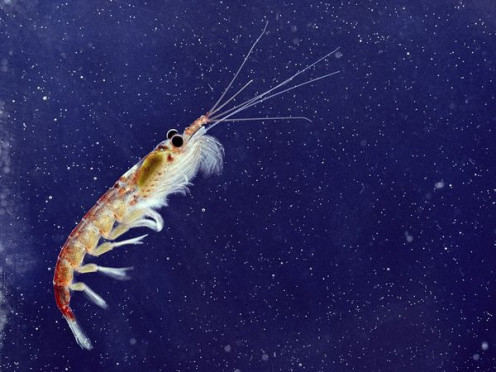
Shella's Fish IQ Test!
view quiz statisticsMarine Predators and Their Jobs
Marine predators come in all shapes and sizes. Some of the most deadly could fit in the palm of your hand and move slower than a land snail... others weigh many tons and are equipped with teeth, spines,barbs and other more recognizable hardware.
In every ecosystem there are predators. These organisms are essential to any living system. Most of us think of Marine Predators and shiver... sharks, barracuda, jellyfish, poisonous fish etc. But the purpose of these critters with bad reputations can be narrowed down to two points:
- Crowd control
- Natural Selection
Crowd control:
Imagine an ocean... let’s make one up! Ok, so let’s say that within our new little ocean there is a healthy sized population of algae, phytoplankton, plankton, invertebrates, mackerel, tuna and a predator... let’s say Great White Sharks.
This ocean functions because there is a balance in the populations. The sharks feed on the tuna, the tuna on the mackerel and so on down the food web. But let’s mess with the system a bit.
Let’s cut the Tuna population in half.
The top predator, the sharks, quickly go through the reduced tuna population and die out. The mackerel have no predator since the tuna are gone.. so their population explodes! As good as this sounds for the mackerel... in the long run, it is a disaster. Now our little ocean has too many mackerel... and the mackerel feed on the invertebrates and plankton... so rather quickly, both are wiped out... then the mackerel has no food source... and the mackerel die. The algae now have no predators since the invertebrates have been wiped out... so there are massive algae blooms... which in turn block the light from getting to the sea floor, depriving any corals and seaweed of food, so they die. The water then becomes de-oxegenated... so anything that is left dies...
Just by cutting one critter’s population in half in our imaginary ocean... everything is affected... and in our case... dead.
The Tuna’s job as the Mackerel’s predator is to keep the population in check. As we just saw, any significant rise or fall in a population within a system and the entire thing collapses.
Natural Selection:
Let’s start over, same critters, same little ocean. Back to our Tuna. Most populations follow something called a bell curve. Let’s say the bell curve is a representation of the tuna’s swimming speed. The majority of the population swims at an average speed and lie within the “bell”. To the left are the tuna that swim slower than average, and to the right are the faster. The slower tuna will be eaten causing the entire bell ( the population) to move to the right.
Naturally... the sharks are able to pick off the slower swimming fish. These fish that are caught and eaten will not breed, and therefore not pass on any mutation or trait that caused them to be slow. This process is known as survival of the fittest and it is this process that fuels evolution and improves the genetics of a population! The result is a faster next generation. Without predators to cull the weak , sick and wounded, a populations genetic integrity would be compromised, potentially causing the population to develop a negative trait after a few generations which can then lead to the extinction of the population, if not the species. Predators may seem nefarious... but their job is essential and most do it very well.
As I said earlier, marine predators come in all shapes and sizes. The whale shark, for example, is the largest fish in the sea... and a shark that can grow to over 40 feet. Scared yet? Don’t be. These are gentle giants, but are still technically predators. The largest fish in the sea actually eats one of the smaller collection of critters in the sea, krill.
Krill are very small invertebrates closely related to shrimp. The Whale sharks open their 4 foot wide mouths and filter out the krill using their gill rakers, much like a whale using its baleen strainers. The whale shark is an active hunter... only much slower than we usually think of a predator behaving. This is in sharp contrast to another shark, the Mako. This shark is one of the fastest fish in the sea clocking almost 38 miles per hour. This shark is a streamlined, hydrodynamic hunting machine. This shark and other open water sharks like it, have a 6th and 7th sense they use to track down and identify potential prey over great distances. The black dots on the nose of this mako are known as the ampullae of Lorenzini... a fancy name for what is basically a jelly filled hole in the skin. Inside this hole is something like a tiny hair surrounded by a jelly like substance. These hairs can detect even the slightest pressure changes in the water... as slight as a heart beat from miles away. The signal is sent though the base of the hair to a bundle of highly sensitive nerves, then straight to the brain. Using these pitts spread across its face, a shark can identify what direction their prey is in. The other super sense these predators have is called the lateral line. This a system of sense organs that detect movement and vibration in water. All vertebrate fish have this tool and it is vital to schooling fish which require the ability to move as a unit for protection.With speed, excellent sight, and their extra senses, it’s no wonder sharks have been around for tens of millions of years.
This animal is well known, but not necessarily for the predator that it is... the Starfish! Believe it or not, this invertebrate is a voracious hunter. Another “slow” hunter, the group commonly known as starfish, are in fact not a fish at all. Bat stars, brittle stars, common starfish, and crown of thorns stars are just a few of the over 1,500 species and all of them are carnivorous. A very smart person with very untidy hair once stated that time is relative. These predators appear to be almost unmoving to one sitting and watching them, but speed up the action and you can see an active predator.
If you have ever seen the show “Sponge Bob” , you know the character Patrick Star... and you know he’s not the sharpest crayon in the box... While this makes for a funny character, his lack of intelligence is based on biological fact: Starfish don’t have a brain! Instead they have a very simple nervous system that controls movement and light reception. At the tip of each arm there is an eye spot. It cannot see the way we can, but it can detect light and shadow. They have another strange practice... they regurgitate their stomach out of their “mouth” and envelope their food outside of their bodies, allowing them to eat things such as muscles, coral and barnacles which adhere themselves to a rock and are almost impossible to remove. Minimum effort, maximum output. Instead of having to pry it’s prey off a rock and then either having to open a shell or digest hard calcium... the brilliant brainless starfish just smothers it’s prey in its stomach and digests the ‘yummy parts’ . It’s weird... but it works!
All living organisms are a part of a complex web in which everything eats something. Because all organisms are connected, even the slightest change in population size can cause dramatic damages to the web as a whole.
Starfish Hunting
Which Marine Animal Do You Fear Most?
Which Marine Animal Do You Fear Most?
Imagery from Pick Your Poison
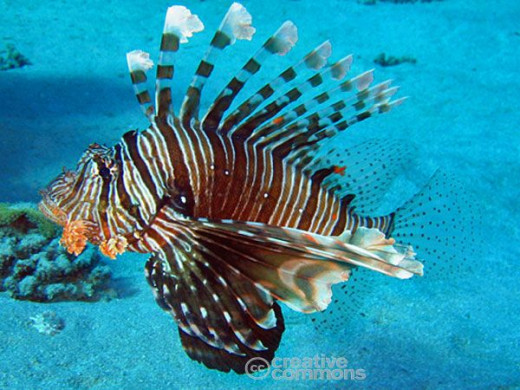
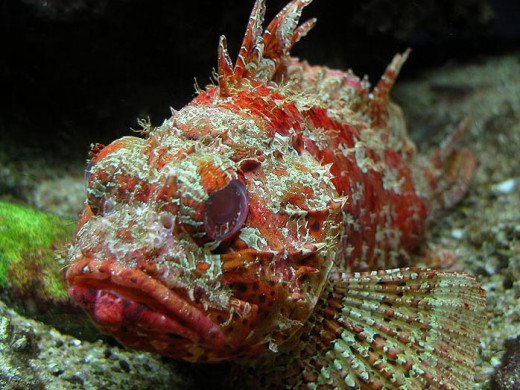
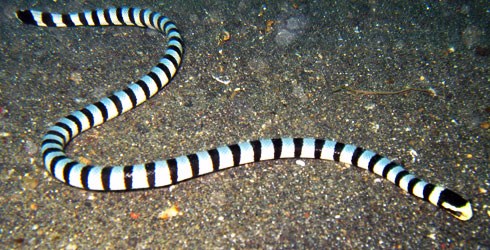
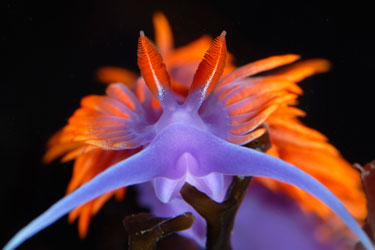
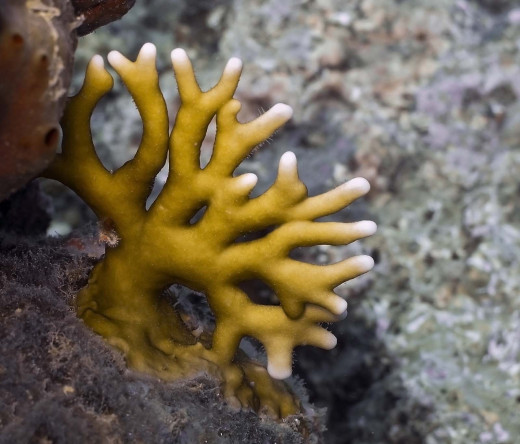
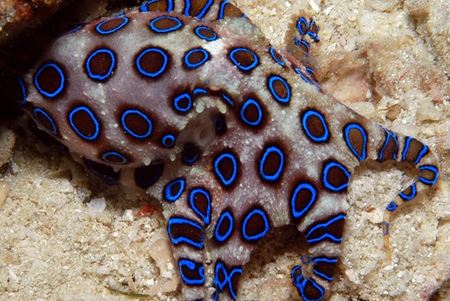
Cnidocytes Firing! ( Jelly fish stinging cells)
Pick Your Poison. An Examination of Poisonous Marine Life
Unlike on land, venom in the oceans is mainly* used as a defense mechanism rather than a means for killing prey. There are many species of poisonous fish out there, some with spines, some with poisonous organs. These critters often have a clear display showing any and all predators that they are not to be messed with. Bright colours, elaborate patterns and clearly visible weaponry alert all who see them.
The lionfish for example, is a slow swimmer. It can afford to be slow because of the highly toxic venom in the spines that make up their dorsal and pectoral fins. These fish carry a warning as well in their stripes. Bright patterns are often used as a warning sign to prey, much like certain insects on land.
Another poisonous fish is much harder to see. The scorpion fish has evolved the ability to blend in perfectly with the surrounding coral and rocks. This sneaky fish has venomous spines that can instantaneously incapacitate their prey or a predator looking for a bite, making them an easy meal and deterring any would be predators. The group of scorpion fish is believed to contain some of the worlds most lethal venom.
*The Banded Sea Krait is a sea snake with a powerful venom 10x more toxic than a rattlesnake! One of the few remaining Marine Reptiles, the Krait is rarely dangerous to humans. It mainly feeds on eels and bony fish and uses its venom to incapacitate their prey.
Nudibranchs (nude-eh-bra -nks) are my personal favorite out of all invertebrates. While they are slugs, they put any land slugs to shame with their brilliantly colorful and elaborate displays. Without shells or bones or really any hard tissue, it would appear as if these slugs were defenseless... but think again! These creatures have a unique form of poison production. They imbibe toxins by ingesting poisonous sponges and anemones , storing them for later, and then secreting out the poison when threatened. They broadcast their poison with bright colors and patterns which tell predators that they are anything but delicious.
Fire coral is every diver's enemy. I have personally experienced the intense burning sensation that comes from this critter. While it is called a coral, it is actually more closely related to jellyfish. It is commonly considered a coral mainly because it is immobile. Like jellyfish, fire coral possesses specialized stinging cells called cnidocytes. I have posted a video showing these cells up close. They behave much like a harpoon gun, triggered by the slightest disturbance, they shoot out a poisonous barb. Of course these are microscopic, but they are so tightly packed they pack quite a punch.
The Blue Ringed Octopus is one half of a deadly pair. They have a symbiotic relationship with a specialized bacteria that lives in their mucus glands. These bacteria produce a deadly neurotoxin that can kill a full grown man in mere minutes in exchange for a safe home. The toxic slime is also useful to the octopus in digestion of shelled prey.
Imagery from In Plain Sight
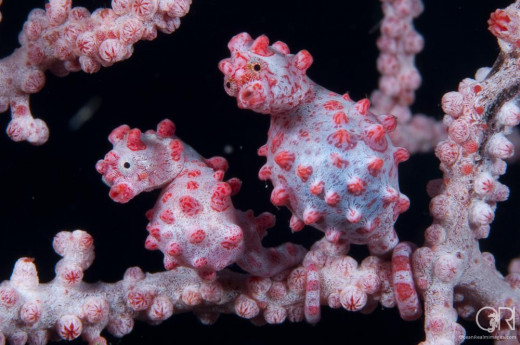
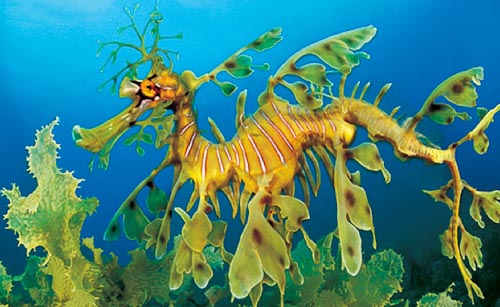
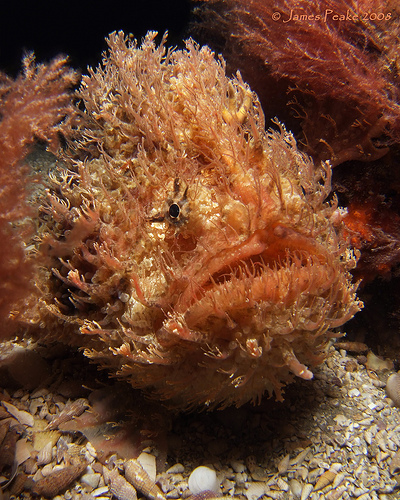
Frog Fish Feeding
In Plain Sight. Camouflage Techniques of Marine Organisms
Long before soldiers donned "camo" fatigues, before men painted their faces to blend in while hunting, before human beings, before life on dry land, marine animals had already been developing forms of camouflage for millions of years. The disguises vary from subtle to elaborate and allow the owner to hide from their predators, hide from their prey or even mimic other animals.
Seahorses are a perfect example of some elaborate disguises. The Leafy Sea Dragon has evolved thin, elongated lobes of tissue that mimic seaweed all over its body. This disguise allows the Sea Dragon to live, hunt, and breed in the safety of the fauna of the sea floor, out of sight of any would-be predators. Another species of seahorse, the pygmy seahorse , has evolved to blend in almost seamlessly with its home on a variety of fan and soft corals. Their camouflage is so effective, we only discovered their existence when a sample of soft coral was being examined in a lab!
The Tasseled Anglerfish is an assassin in waiting. It has evolved to blend in with surrounding rocks and the fauna covering them, in order to lay in wait for their prey to swim by. It is a smart strategy. The fish doesn't have to waste any valuable energy chasing or hunting their prey. They have another feature that aids them in catching their prey. As their name suggests, they have an angler. Some anglerfish have a lure that mimics a worm, or a distressed, injured fish. These lures draw prey right into the anglerfish's trap. Once the prey is within range, the anglerfish's lightening- fast movement engulfs the prey in the blink of an eye. The Anglerfish uses energy maintaining its elaborate disguise rather than the pursuit of prey.
The Mimic Octopus is the ninja of disguises. It is well known that cephalopods are intelligent, but this species puts all other marine fish and invertebrates to shame. The Mimic Octopus has the ability to mimic an astounding 15 recorded different organisms including flounders, lion fish, sea snakes, and sea weed. Its ability to learn the behaviors of other creatures is slightly... unsettling as it requires a certain level of intelligence not normally associated with these creatures.
The frog fish... actually freaks me out a tad. This fish has ... wait for it... hands. Not hands like ours, but while it can swim, it also can walk across the bottom or grip onto rocks using its highly specialized pectoral fins. They come in many colors and shapes and are often very bumpy, so as to appear as a rock or other inanimate object. They have lures, and will sit absolutely still, only twitching it's lure until a fish comes into range and then... bang the entire fish is gone. The frog fish can swallow its prey whole... even prey its own size! Freaky, right? Its gills are under its arm pits to percent the motion of it breathing from being seen by prey and it has a secondary pair of pectoral fins allowing it to stay as still as it must. This fish breaks all the rules by using mere stillness as its camouflage.
All of these critters and many many many more are masters at hiding in plain sight. This ability allows them to hunt and hide for their own survival in a world where everything eats something else.
Bioluminescence. Living Light
Greek:
Bio - Life or Living
Lumen- Light
The ability for certain living organisms to create light is nothing new, but it is relatively newly discovered by man. The sub surface light show that is constantly taking place under the waves is both fascinating and intriguing. Some organisms have the ability to create light themselves, others utilize a symbiotic relationship in order to achieve light. This living light comes in different colors and has many different uses including but not restricted to offense, defense, mating, communication, and even camouflage.
Bioluminescence is found in many marine organisms from algae and bacteria, to large deep sea predators. It is particularly useful in a world where the sunlight has never and will never penetrate. While there is no way to prove an organisms intentions, it is believed that certain cephalopods use their light to communicate and to distract predators and prey. There are shrimp that release a sticky glowing goo that sticks to the predator that had alarmed them, turning the predator into a glowing meal ticket for any larger predators. The dragonfish even uses its light as headlights! It uses a rather unique shade of red light that is invisible to its prey to hunt in the black cold deep. Spooky, right? Other fish use their light to break up their profile and appear smaller so as to not spook their prey. Bioluminescence is a useful and beautiful trait that turns the dark into an organic light show. I have personally witnessed this on a night dive in the pacific off of San Clamente Island. It is like magic, only better because it's science!
Please watch the video below from TedTalks! It is a brief talk about bioluminescence with awesome video of live marine life making light!
Bioluminescence video from TedTalks
Polyp & Medusa Body Plans
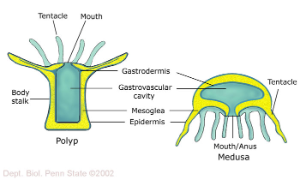
Cnidarians: Hydra and Medusa
In greek mythology there are two monsters that are particularly memorable: The Hydra and the gorgon Medusa. The hydra is described as a serpent-like beast with hundreds of heads and for every head cut off, two more would grow in its place. The gorgon, Medusa, was a chthonic beast in the shape of a woman with snakes for hair. These myths were the inspiration for the names of the two factions of the Cnidarian family. Hydra describes any stationary cnidarian with upward facing tentacles and Medusa is any mobile cnidarian with downward facing tentacles. Get it? The tentacles facing up look like the many headed hydra, and the tentacles that hang down look like the snakes on medusa's head. Now you know!
The phylum of cnidaria contains over 10,000 different species including species of jellyfish, corals, anemones and more.
Hydra : Anemones, Corals, other polyp cnidarians
Medusa: Jellyfish
All cnidarians have radial symmetry, meaning the body plan resembles a pie where several cutting planes produce roughly identical pieces. They also all possess cnadocytes, or stinging cells.
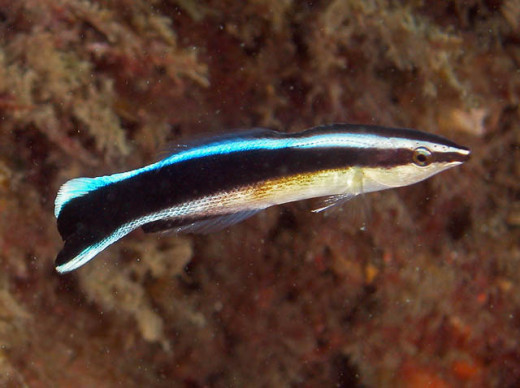
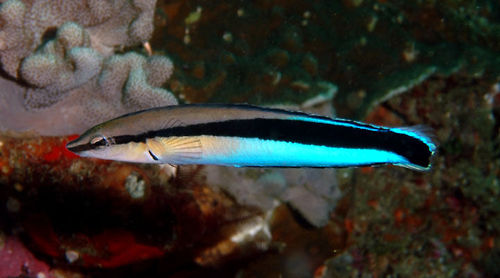
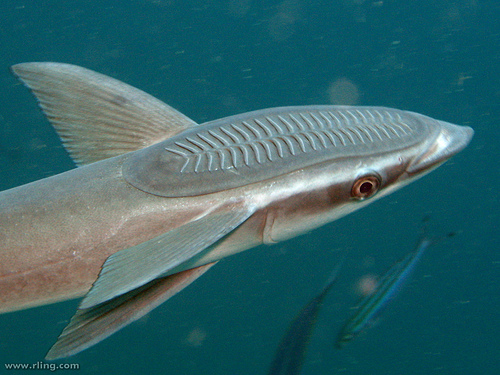
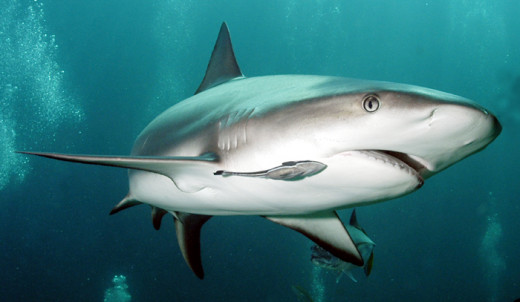
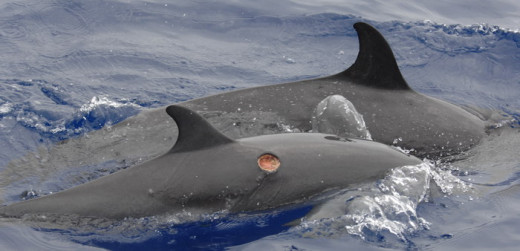
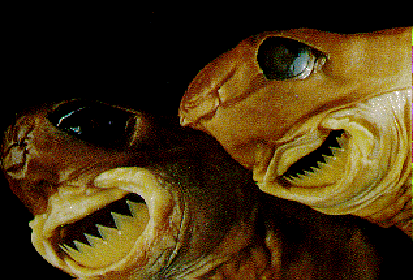
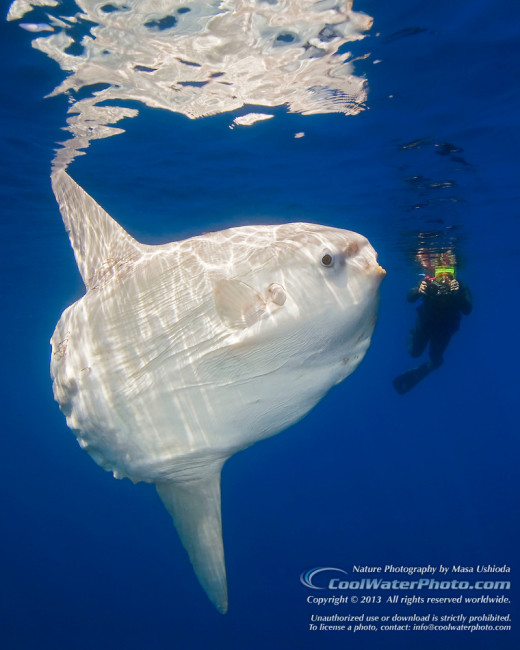
By Request: Parasitic & Symbiotic Relationships
To some fish, other fish really are friends, not food! Just like on land, there are many examples of marine organisms working together for mutual benefit, and plenty more examples of animals "mooching" off of a host.
These are examples of relationships that are visible without a microscope.
Cleaner Wrasse
The Blue Streak Cleaner Wrasse is a small thin fish that, as the name suggests, cleans other fish! These fish have "cleaning stations" where they wait for larger fish to form a cue. The wrasse then does a little dance for its "client" and once the client signals it's amiable, the wrasse will clean all of the dead tissue and parasites away. The wrasse will even venture into the mouths of some pretty dangerous fish to clean out any leftovers from between the teeth. Groupers, sharks and other predatory fish frequent these cleaning stations and spare the wrasse's life and provide it with food in exchange for the removal of annoying parasites and dead flesh. This interaction is an example of symbiosis because both parties benefit.
A perfect example of the differences between a parasitic and symbiotic relationship, the False Cleanerfish is a wolf in sheep's clothing. This fish is no wrasse at all but is actually a blenny disguised as a cleaner wrasse. This nefarious blenny has almost identical markings and shape to the wrasse and will even mimic its dance to tell clients that the cleaner shop is open, but when it comes down to it, the blenny will actually take bites out the client and continue to do so until the client realizes its been had and shoos the blenny away. This is an example of a parasitic relationship because the blenny is the only beneficiary and the host is harmed (very minimally) . Most parasites will take up residence within a host. The blenny is more of an opportunistic parasite.
Remora
The remora is an odd looking fish that has a section of modified scales on its head that act like Velcro allowing it to stick to the skin of larger fish such as sharks and rays. This fish hitches a ride on larger predators and picks up the scraps, removes parasites and may feed on the feces of its host. The remora has to be careful which hosts it tries to hitch a lift on as they can quickly become the prey of a shark who isn't in the mood to have a stow-away.
Cookie Cutter Shark
The Cookie Cutter Shark is a tad on the creepy side, but it has adapted a very effective strategy for getting food. This shark is also known as the cigar shark due to its shape and small size. They can grow up to 22 inches and are yellow/brown. These sharks also have photophores, or specialized cells that are able to produce bioluminescence. The sneaky little guy waits in the water column ( mid depth) for a large animal such as a whale, dolphin, shark etc to swim past and then it attacks. Before the large animal knows what hit em, the cookie cutter shark swims up and takes an ice cream scoop sized and shaped bite out of it and swims away. They have a specialized lower jaw with sharply pointed teeth that can swing forward in to the flesh cleanly removing a scoop. This does not cause the "host" any serious harm because it is such a small bite out of a large animal, but it is still an injury so the Cookie Cutter Shark is considered a parasite.
Sunfish and Birds
The relationship between the Sunfish ( also known as the Mola Mola) and sea birds breaks all the rules. This is between a marine animal and a land animal and is quite rare if not unique. The sunfish is a slow swimmer, making it vulnerable to parasites that burrow into their skin and cause irritation. When the Sunfish can take this itching no longer, it will go up and lay sideways on the surface. Sea birds see this signal and will land on the sunfish and pluck out the annoying parasites and eat them. The birds get food and the sunfish gets relief from the pesky parasites.
The Birds and Bees Under the Seas
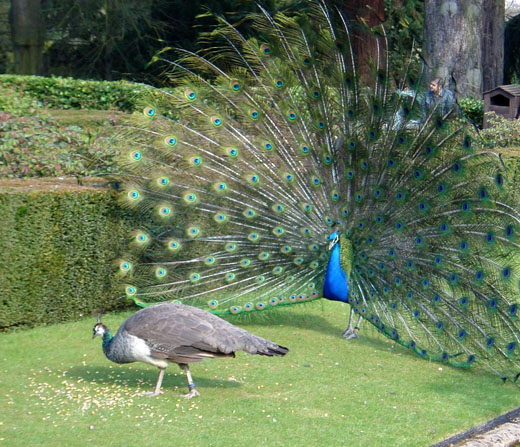
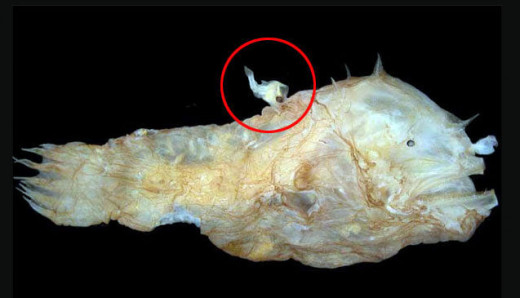
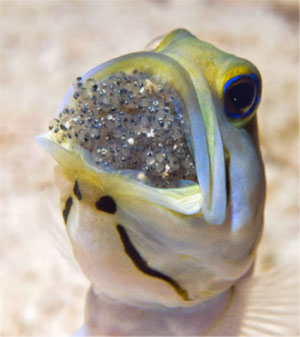
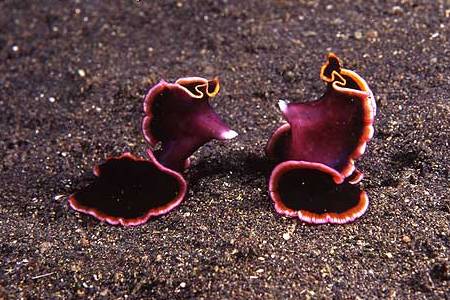
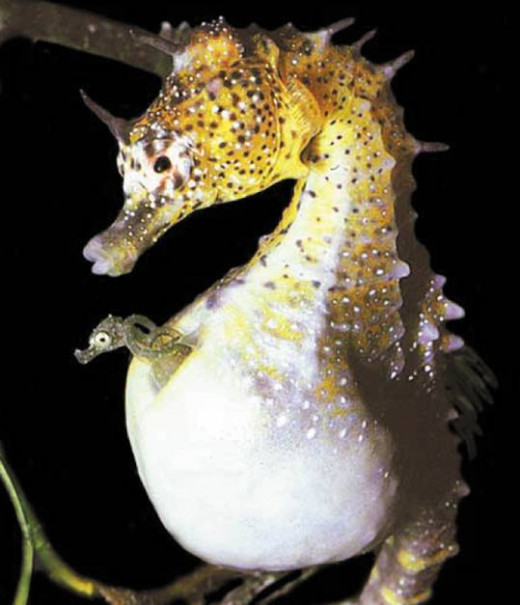
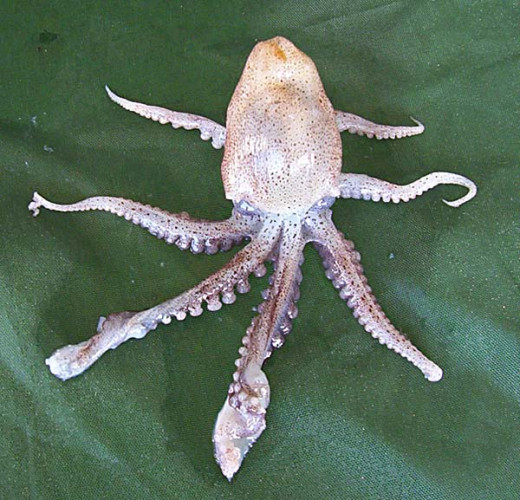
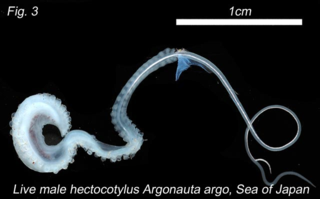
The Birds and Bees Under the Seas
Procreation. Yes ladies and gents, this segment is all about it. Reproduction fuels evolution caused by the natural selection of adaptations in a process known as sexual selection. Sexual selection causes a phenomenon known as sexual dimorphism, that is, the obvious difference in the appearance, lifespan or size between the male and female of any one species. An example of this would be the male and female peacock. The female is modestly colored while the male sports an extravagant array of color and plumage. The traits that females find the most attractive are passed on and over many generations they get more and more extreme resulting in the male and female looking entirely different. Under the water, reproduction can get pretty weird and wild.
The Deep Sea Angler fish
This relationship hardly seems fair. As with many marine organisms, the female deep sea angler fish is larger than the male... but in this case she is up to 10X larger! Imagine, if you will, being a fish in the deep ocean ecosystem. There's no light and life in general is very VERY spread out and populations of any one species are generally rather small. The majority of fish down there opportunistic feeders, meaning they will eat anything that happens to swim by because they never know when they will see another potential prey item. As rare as finding prey is... finding a mate even less likely. The angler fish has evolved a way to solve this problem.
Many a year ago, scientists were studying angler fish and realized something odd... all the fish they were pulling up were female, and they all had these odd looking parasites fused to their bodies ( see photograph). After careful examination it became clear that those parasites were actually ... wait for it... yes. The male Angler fish.
The female angler fish will be swimming around in the dark and a male will happen to swim near by. The male will then swim right up to the female and bite her with special jaws that adhere him firmly. Over time, the male's body will fuse with the females at the bite site and will begin living off of her blood supply, effectively becoming a part of her. All bodily functions in the male will cease, with the exception of sperm production resulting in the male becoming little more than a testicular skin-tag. This adaptation allows the female access to sperm any time she wishes to reproduce, effectively solving the "hard to find a mate in the dark" problem. A female can have numerous males attached to her which she provides nutrients for in return for their ... well ... you know... services. ( I apologize for the creep-factor of the pictures... angler fish are ugly no matter how you photograph them)
Flatworms
Flatworms are hermaphroditic, meaning they are simultaneously male and female. This is beneficial when it comes to reproduction because every other flatworm of the same species one runs into is a potential mate. In such a situation the only question is who is playing which role. The way the flatworms decide this is rather comical. They participate in a practice known as "Penis Fencing". The flat worms literally joust or fence with their two dagger-like penises in a violent attempt to pierce the other's skin and inject its sperm. The victor is then dubbed the male and impregnates the loser who takes on the role as female. These primitive worms really have no rules when it comes to reproduction.
Seahorse
Everybody knows the male seahorse gives birth to live young instead of the female. BUT do you really know how it happens? Did you know that technically the female gives birth to the fertilized eggs? She mates with the male and then instead of laying her eggs on a rock or within a bed of sea grass, she lays them in a special pouch on the male's front. The eggs are then carried by the male until they hatch at which point they are expelled from the pouch. This behavior is not necessarily as unique as most believe.
There are many species of fish that participate in mouth brooding or oral incubation. Like the seahorse, the female fish will mate with a male and have her eggs fertilized. She will then lay her eggs into the sea floor and then either she or her mate will scoop them up into their mouth. This behavior allows the parents to protect their brood without having to remain in one place, guarding the next. After the baby fish, known as fry, hatch, they will often use the parent's mouth as a sanctuary when threatened until they grow too large to fit.
Paper Nautilus
This is another one of those "Thank GAWD we don't do it that way" methods. Like the angler fish, this species exhibits extreme sexual dimorphism. The female paper nautilus is up to 5X larger than the male and lives far longer than the male who only lives long enough to mate once. The male nautilus, like most octopods, have a tentacle that functions as a penis called a hectocotylus (it holds a packet of spermatazoa). When the male nautilus comes across a female he likes, he will detach this special arm which will swim... on its own... over to the female and burrow its self into her, crawling around until it finds her gill slit where it waits for her eggs to be ready for fertilization. When her eggs are ready, the female will remove the arm and the sperm packet and sprinkle the contents over her eggs. The male dies shortly after his arm-penis detaches, while the female lives long enough to reproduce many times. With many aquatic organisms, the male's sole purpose is reproduction.
If there are two things to "take home" from this they are:
- The ocean is a strange and mysterious and sometimes messed up place
and
- In the oceans, the male usually gets the short end of the deal
Shella's Deep Sea Critter Quiz!
view quiz statisticsMedicine From The Sea
Reasons For Us To Save Our Seas!
- A Caribbean sponge has been discovered to generate compounds used in AZT (zidovudine,Retrovir), which is used to fight the AIDS virus.
- Caribbean gorgonian (a soft coral) produces a group of compounds with anti-inflammatory properties, which are also included in an anti-wrinkle cream.
- A tentacled aquatic organism, called bryozoanBugula neritina, yields a compound being tested as a cancer drug.
- Skates (a flatfish shaped like a kite) have provided clues used in treating vision loss.
- Corals and mollusks are used to make orthopedic and cosmetic surgical implants.
- Horseshoe crabs are commonly used to test for bacterial contamination.
- Microalgae are used in vitamins and other nutritional supplements.
- Bone grafts from coral skeletons, pain relievers from sea snail venom, and infection-fighting agents from sharkskin are all under study.
Source: http://www.noaa.gov/features/economic_0309/medicines.html
Sharks: Prehistoric to Present!
I just got my copy of "Sharkabet" by Roy Troll in the mail today!! I am so in love with this artist's entire body of work, but this book is just amazing!! It's a picture book for all ages and it has amazing illustrations and great scientific facts!
Here are the sharks included in the book!!
A- Angel Shark
B- Bull Shark
C- Cookie Cutter Shark
D- Dogfish
E- Elephant Fish
F- Frilled Shark
G- Goblin Shark
H- Helicoprion (E)
I- Iniopterygians (E)
J- Japanese Devil Ray
K- Kidney- Headed Sharks
L- Listracanthus (E)
M- Megalodon (E?)
N- Nurse Shark
O- Ornithoprion (E)
P- Petalodonts (E)
Q- Queensland Sawfish
R- River Rays
S- Scissor- Toothed Shark (E)
T- Thresher Shark
U- Urolophus Rays
V- Varied Carpet Sharks
W- Whale Shark
X- Xenacanth Shark (E)
Y- Yellow Shovelnose Guitarfish
Z- Zebra Shark
(E) - Extinct
Sharks!
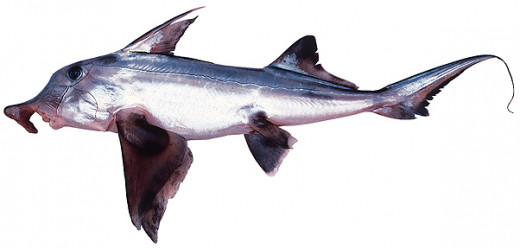
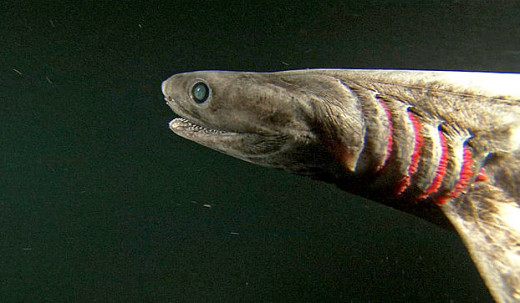
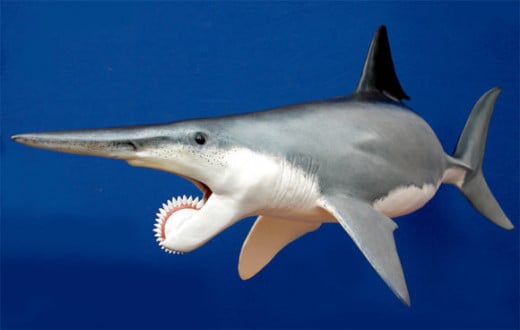
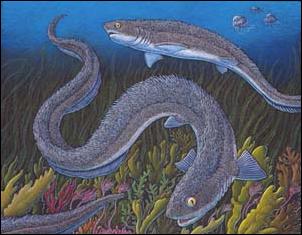
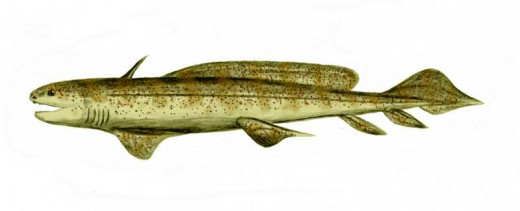
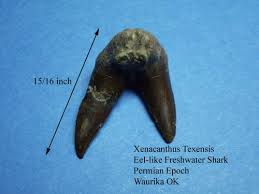
Spotlight: Sharkabet by Ray Troll
Here is some fascinating information on some of the lesser- known and/or extinct sharks from the book Sharkabet By Ray Troll!!
Elephant Fish- also known as the Australian Ghost Shark, this is a species of Chimera. Chimera are a type of cartilaginous fish classified as an Elasmobranch along with sharks and rays. The Elephant Fish uses its strange nose to "sniff" out prey using its specialized sensors ( See "Predators" article below for more detail on the ampullae of lorenzini).
Frilled Shark- The frilled shark is often called a "living fossil". It is dark brown with a long (6.6ft) eel-like body. It's name comes from the appearance of its gills which stick out from the gill slits. These sharks sport triple pronged teeth and very small eyes that are suitable for it's deep, dark environment. Because they live so deep they are no threat to humans.
Helicoprion- This extinct shark had one strange looking head. Also known as the "can opener shark" the helicoprion had a tooth whorl outside of its mouth. The majority of sharks have a "conveyor belt" of teeth in a spiral in their jaw, but this shark's whorl was exterior.
Listracanthus- This extinct species of shark is known for its covering of odd feather-like denticals that covered its body. Not much else is known about this shark due to the absence of detail in the few fossils found.
Xenacanth Shark - This is an extinct species of fresh water shark that roamed the swamps of what is now the south west of the United States. It grew to around 3 feet long and sported an impressive spike protruding from the back of its head, making it virtually impossible to be swallowed by a larger predator. It had strangely 'V' shaped teeth and probably fed on crustaceans and small fish.
These are just a few of the sharks in "Sharkabet". I highly recommend checking out this book!!
Here's The Link!!
Working with The Coral Restoration Foundation!
This summer I had the amazing opportunity to work with the Coral Restoration Foundation in the Florida Keys! It was an amazing experience that I highly recommend! Through CRF I learned a lot about corals and their decline in the Caribbean Sea. After a presentation that taught us about the facts and the methods they use, we headed out to the boat and got ready to dive! We went on two dives, the first at the coral nursery, and the second at a 'wild' live reef. During the first dive we cleaned and harvested elk horn coral that was hanging from trees made of PVC and anchored to the bottom. This nursery was spread across around an acre of barren sandy sea floor. We gathered up the coral pieces we had harvested ascended back up to the boat to head to our second location. This was a natural reef off of Key Largo. We then planted the coral in thickets using a natural epoxy. This part was so cool because I was able to note the GPS coordinates so I can go back and visit and see the coral I planted. Some day it will be a big thicket that provides a home for other organisms as well as being a healthy stand of elk horn coral.
Working with CRF was such a great experience. The staff was knowledgeable and friendly, and the work was more like play! I highly recommend volunteering for CRF to any of my fellow SCUBA enthusiasts. Please check out their link below!
Coral
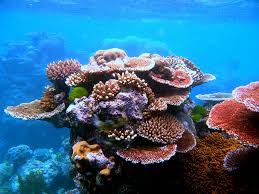
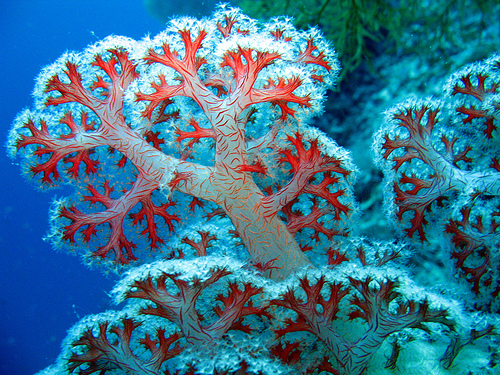
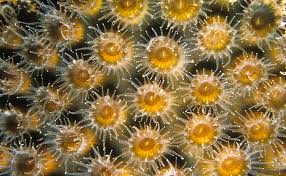
The Hard Truth About Coral
Some coral may look rather like a rock... but look closely and you will see a complex organism that is tightly connected with the organisms around it.
Coral reefs provide food and shelter to an enormous variety of marine plants and animals. From the tiny bacteria and algae that live symbiotically with them, to sharks cruising the reefs in search of prey, coral caves inhabited by octopi and dead coral providing an anchoring point to numerous species of plant and invertebrate animals, coral is vital to the survival of the entire ecosystem.
Corals are a type of Cnidarian, like jellyfish and anemones. They are soft bodied and contain tiny stinging cells known as nematocysts ( see previous article about Cnidarians: Hydra and Medusa). Unlike its cousins though, corals produce a calcified exoskeleton. Many species of coral reproduce by releasing their sperm and eggs into the water and when they meet they eggs are fertilized and , eventually, they land. Each individual coral lands head down and begins to secrete its calcified mucus that hardens into its shell. If you look VERY closely at coral you can see the soft little critter inside. It lives its entire life doing a head stand, with its feet waving out in the water to catch food and bring it into the mouth.
Coral is colonial, they live in large groups and can function as a unit. Over many many years a reef is formed from new coral landing on top of old coral and building up magnificent structures.
Most corals require sunlight to survive. This is because while they catch floating plankton, fish fry, etc, they gain the majority of their nutrients from a type of photosynthetic algae that lives in its body, called zooxanthella ( zoo-zan-thally). This algae is very sensitive to the temperature and chemistry of the water and will vacate their host coral if the conditions are not correct, leaving the coral to starve. This is called Bleaching. The corals actually get their color from their unique zooxanthella, so when the algae leaves the coral, it leaves the reef white and dead looking. Pollutants that are dumped into the Mississippi river, for example, make their way out to the Caribbean Sea and have caused mass die-offs of coral and as a result, threaten all of the animals that rely on the coral for food and shelter.
Many people don't know there are both hard and soft corals. Hard corals are the most recognizable as coral. They look rather like a rock, live in vast colonies and provide the structure needed for a reef. Soft corals are also known as sea whips, sea feathers and sea pens. They are flexible and sway in the current.
Coral is a food source for a few hearty fish out there. The parrot fish is a brightly colored, odd looking fish that sports a rather odd looking beak. The beak is necessary for the parrot fish to get through the hard calcium that protects the coral. The parrot fish gnaws on the coral ( ever hear a snapping and popping sound in the ocean while your snorkeling? It was probably a snacking parrot fish! ) and digests the algae and the coral invertebrate, but it cannot digest the calcium... which it passes as waste! Those nice sandy beaches you've been enjoying in the tropics... Parrot Fish Poop1!!
Coral also has some very practical qualities in the medical field. Certain chemical compounds have been found in coral species that are currently being used to fight AIDS, battle cancer, and reduce chronic pain. Coral skeletons are also being used for bone grafting! The empty calcium lattice work provides an excellent surface for new bone growth in replaced joints and other procedures.
Corals are beautiful, important, and often underrated creatures that are essential to our current oceanic environment. By introducing pollutants into our water ways, even our fresh ones, we are putting the delicate balance required for their survival at risk!
1 Erosion is also a contributor... of course!
Scales and Skin!
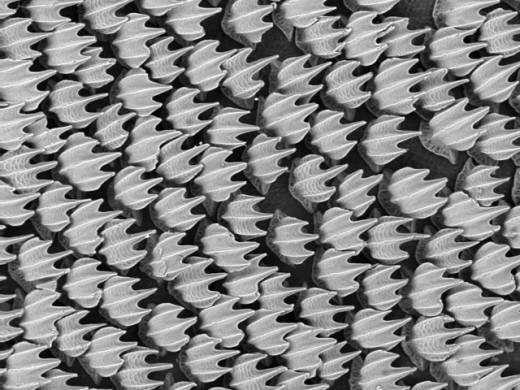
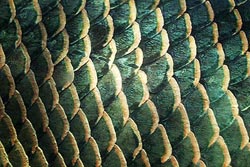
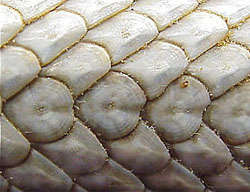
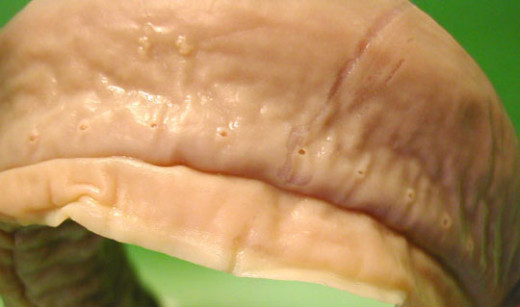
Teeth, Skin and Scale
As I hope you are aware by now, thing are a little different under the sea. While we see scales on reptiles and birds all the time, scales below the waves are built to be hydrodynamic and at times work as a suit of armor against predators.
Scales.
Fish scales range in size from large rigid armor to microscopic nearly smooth skin. Fish scales fit into certain categories:
- Cycloid: These scales have a smooth outer edge and are found on fish with soft rays such as salmon and carp.
- Ctenoid: These scales have a rough, toothy outer edge, giving them a rough texture. These scales have little to no bone and get their rigidity from collagen. They are most commonly found on fish with spiny fin rays such as perch.
- Placoid: These scales are found only on sharks, rays and chimeras. Also known as Dermal Denticles , these scales are actually tiny teeth! Each denticle has its own blood supply and is covered with a hard layer of dentin, just like our own teeth, though these are much sharper! The denticles all point toward the tail resulting in a smooth texture in one direction, and a very rough texture toward the head. Some sharks, such as the whale shark, have skin so strong they are bullet proof even at close range!
- Ganoid: These scales are rigid, plate like and tough. They are found on fish such as gar and sturgeon. They overlap each other closely, creating a tight armor like chain mail.
- Elasmoid: These are thin bony scales. At their thickest, they resemble a human thumbnail. They are found on lobe finned fishes such as the Coelacanth.
Skin
Ever notice how our skin gets all pruned when we are in water for any length of time? This is because the surface skin cells absorb water and swell while the layers of cells below them do not... skin belonging to an aquatic animal cannot have this problem. Many marine animals with skin secrete a thick goo, for lack of a better word, that acts as a barrier from the salt water, a lubricant for getting in and out of small spaces, and often a deterrent from predators.
Imagery for "Now That's a Face For Radio"
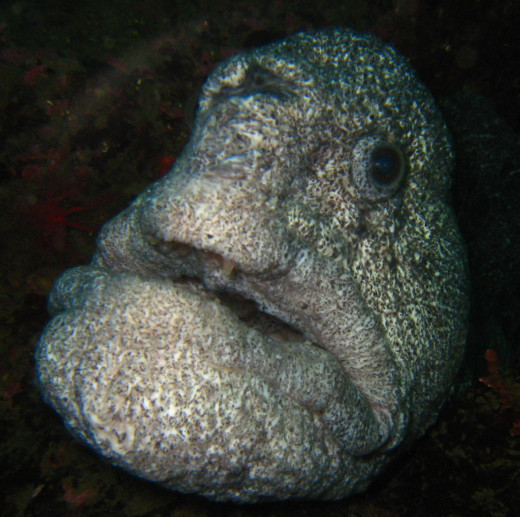
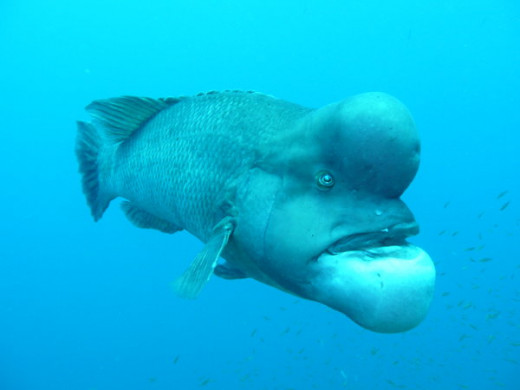
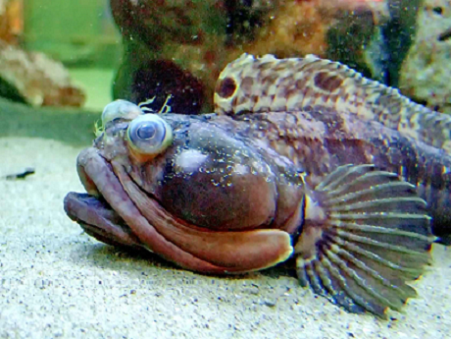
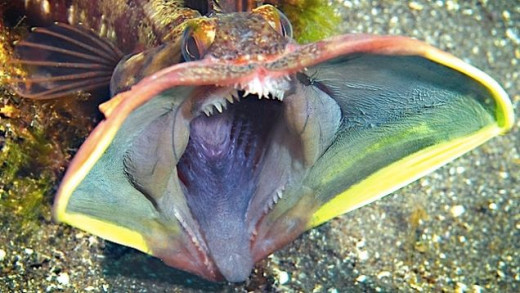
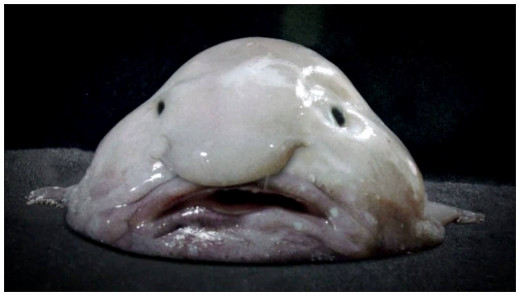
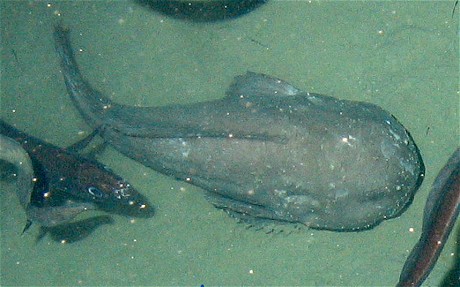
The Sarcastic Fringehead in Action.
Now That's a Face For Radio
Some sea creatures are downright gorgeous. There are fish who display a myriad of colors and patterns, sea slugs who look etherial and as fragile as lace... and then... there are critters who are so hideous... they are painted as villainous and nefarious, when in fact they are often just as benign as many of their stunningly beautiful counterparts.
Just like the wicked villains in old fairy tales are often portrayed as hideous, decrepit or deformed, often some of the less attractive marine creatures are assumed to be evil. This bothered me so I decided to take a look at some examples of these rather hideous creatures and find out their true nature.
I started with the Wolf Eel. This is a creature I have been face to face with in the waters off of California's Monterey Bay. It is pasty. It is lumpy. It has teeth. It is UGLY. While called the Wolf Eel, it is actually an "Eel-Like" fish... seems arbitrary to make the distinction since all eels are a branch of fish... and yet... they do. The Wolf Eel is known to be curious and friendly with divers, though there have been incidences when divers were hand feeding them when they caught a finger, but not out of aggression. They are only seen as nefarious because of their appearance and the, let's face it, rather disapproving expression fixed on their faces.
Shrek is a much beloved Ogre from a Dreamworks film franchise that is ugly, grumpy but deep down has a good heart. I promise this isn't some odd tangent. There is a fish... so ugly, so strange and so unnatural looking... it has been nicknamed the Shrek Fish. It's true name is the Asian Sheepshead Wrasse. This is one of the largest species of wrasse world wide. It is found off of China and Japan and is prized for its meat. With no dangerous teeth and a sheepish demeanor, it is no threat to humans in the water, though if caught on a line or a net, it's size and strength can cause physical harm to anyone trying to fight it.
Now for the really strange, highly deceptive Sarcastic Fringehead. His name alone sounds like an insult. These lil buggers grow up to 12 inches in length yet are known to cause all kinds of trouble. It is known for its bad attitude and territorial behavior. Their most bizarre feature though, is their extended mouths hidden by benign looking jowls that rival even those of Richard Nixon. Another odd thing about the Sarcastic Fringehead, When two male's have a territorial dispute, they lock jaws... and almost look like they are kissing! I suppose that's one way to solve problems.
And last but certainly not least... the Psychrolutes marcidus... Better known as the Blob Fish. This deep ocean fish has been voted "The World's Ugliest Animal" in 2014. In my opinion it is hardly fair. This fish lives between 2,000 and 4,000 feet down in total darkness. It's eyes are small compared to the size of its body due to their uselessness. It's pale pink coloration is due to a lack of coloration and scales. It also has very little actual muscle tissue, instead it has a gelatinous mass. All of these facts lead to a fish that when brought up to our pressure levels ( VASTLY less ) It looks like a pale ugly "Blob" with an odd nose. When seen in it's natural environment it looks like any other fish, but once dead and brought up into our own environment, it becomes hideous... again, I think that is quite unfair. If a human were taken down to the Blob Fish's environment... it would be a mass of goo too after being crushed by the immense pressure of the water.
Long story short, judging a fish based on its looks is like judging a book by its cover. These curiosities may not be pretty, but they are still pretty fascinating. Evolution and natural selection have molded them into the strange but their oddness certainly keeps things interesting!
© 2014 Shella Carter

